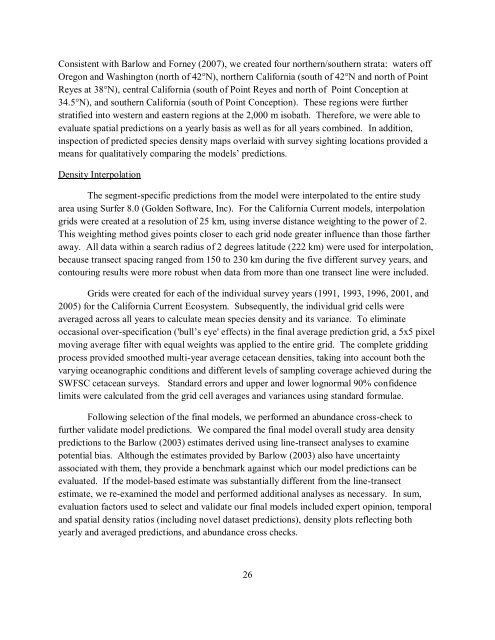Final Technical Report: - Southwest Fisheries Science Center - NOAA
Final Technical Report: - Southwest Fisheries Science Center - NOAA
Final Technical Report: - Southwest Fisheries Science Center - NOAA
Create successful ePaper yourself
Turn your PDF publications into a flip-book with our unique Google optimized e-Paper software.
Consistent with Barlow and Forney (2007), we created four northern/southern strata: waters off<br />
Oregon and Washington (north of 42°N), northern California (south of 42°N and north of Point<br />
Reyes at 38°N), central California (south of Point Reyes and north of Point Conception at<br />
34.5°N), and southern California (south of Point Conception). These regions were further<br />
stratified into western and eastern regions at the 2,000 m isobath. Therefore, we were able to<br />
evaluate spatial predictions on a yearly basis as well as for all years combined. In addition,<br />
inspection of predicted species density maps overlaid with survey sighting locations provided a<br />
means for qualitatively comparing the models’ predictions.<br />
Density Interpolation<br />
The segment-specific predictions from the model were interpolated to the entire study<br />
area using Surfer 8.0 (Golden Software, Inc). For the California Current models, interpolation<br />
grids were created at a resolution of 25 km, using inverse distance weighting to the power of 2.<br />
This weighting method gives points closer to each grid node greater influence than those farther<br />
away. All data within a search radius of 2 degrees latitude (222 km) were used for interpolation,<br />
because transect spacing ranged from 150 to 230 km during the five different survey years, and<br />
contouring results were more robust when data from more than one transect line were included.<br />
Grids were created for each of the individual survey years (1991, 1993, 1996, 2001, and<br />
2005) for the California Current Ecosystem. Subsequently, the individual grid cells were<br />
averaged across all years to calculate mean species density and its variance. To eliminate<br />
occasional over-specification ('bull’s eye' effects) in the final average prediction grid, a 5x5 pixel<br />
moving average filter with equal weights was applied to the entire grid. The complete gridding<br />
process provided smoothed multi-year average cetacean densities, taking into account both the<br />
varying oceanographic conditions and different levels of sampling coverage achieved during the<br />
SWFSC cetacean surveys. Standard errors and upper and lower lognormal 90% confidence<br />
limits were calculated from the grid cell averages and variances using standard formulae.<br />
Following selection of the final models, we performed an abundance cross-check to<br />
further validate model predictions. We compared the final model overall study area density<br />
predictions to the Barlow (2003) estimates derived using line-transect analyses to examine<br />
potential bias. Although the estimates provided by Barlow (2003) also have uncertainty<br />
associated with them, they provide a benchmark against which our model predictions can be<br />
evaluated. If the model-based estimate was substantially different from the line-transect<br />
estimate, we re-examined the model and performed additional analyses as necessary. In sum,<br />
evaluation factors used to select and validate our final models included expert opinion, temporal<br />
and spatial density ratios (including novel dataset predictions), density plots reflecting both<br />
yearly and averaged predictions, and abundance cross checks.<br />
26









